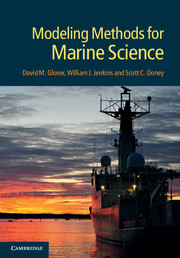Book contents
- Frontmatter
- Contents
- Preface
- 1 Resources, MATLAB primer, and introduction to linear algebra
- 2 Measurement theory, probability distributions, error propagation and analysis
- 3 Least squares and regression techniques, goodness of fit and tests, and nonlinear least squares techniques
- 4 Principal component and factor analysis
- 5 Sequence analysis I: uniform series, cross- and autocorrelation, and Fourier transforms
- 6 Sequence analysis II: optimal filtering and spectral analysis
- 7 Gridding, objective mapping, and kriging
- 8 Integration of ODEs and 0D (box) models
- 9 A model building tutorial
- 10 Model analysis and optimization
- 11 Advection–diffusion equations and turbulence
- 12 Finite difference techniques
- 13 Open ocean 1D advection–diffusion models
- 14 One-dimensional models in sedimentary systems
- 15 Upper ocean 1D seasonal models
- 16 Two-dimensional gyre models
- 17 Three-dimensional general circulation models (GCMs)
- 18 Inverse methods and assimilation techniques
- 19 Scientific visualization
- Appendix A Hints and tricks
- References
- Index
2 - Measurement theory, probability distributions, error propagation and analysis
Published online by Cambridge University Press: 05 June 2012
- Frontmatter
- Contents
- Preface
- 1 Resources, MATLAB primer, and introduction to linear algebra
- 2 Measurement theory, probability distributions, error propagation and analysis
- 3 Least squares and regression techniques, goodness of fit and tests, and nonlinear least squares techniques
- 4 Principal component and factor analysis
- 5 Sequence analysis I: uniform series, cross- and autocorrelation, and Fourier transforms
- 6 Sequence analysis II: optimal filtering and spectral analysis
- 7 Gridding, objective mapping, and kriging
- 8 Integration of ODEs and 0D (box) models
- 9 A model building tutorial
- 10 Model analysis and optimization
- 11 Advection–diffusion equations and turbulence
- 12 Finite difference techniques
- 13 Open ocean 1D advection–diffusion models
- 14 One-dimensional models in sedimentary systems
- 15 Upper ocean 1D seasonal models
- 16 Two-dimensional gyre models
- 17 Three-dimensional general circulation models (GCMs)
- 18 Inverse methods and assimilation techniques
- 19 Scientific visualization
- Appendix A Hints and tricks
- References
- Index
Summary
… [When] you can measure what you are speaking about and express it in numbers, you know something about it; but when you cannot express it in numbers, your knowledge is of a meagre and unsatisfactory kind; it may be the beginning of knowledge, but you have scarcely in your thoughts advanced to the state of science, whatever the matter may be.
Lord KelvinIn science, it's not enough to perform a measurement or make an estimate and report a number. It is equally important that you quantify how well you know the number. This is crucial for comparing measurements, testing theories, debunking bad models, and making real-world decisions. In order to do this, you need to know something about basic measurement theory, and how different sources of uncertainty combine to influence your final results. In this chapter we will be going over the fundamental statistical concepts that lie underneath all that we do when analyzing our data and models. We discuss some important issues that lie at the heart of measurement theory (scales, errors, and roundoff) and look at the concept of probability distributions. Related to this is the very delicate question of whether, how, and why some experimental data should be rejected. In short, this chapter summarizes the science of knowing what you know and how well you know it.
Measurement theory
Systems of measurements (scales)
How we measure or characterize things in science depends on our objectives.
- Type
- Chapter
- Information
- Modeling Methods for Marine Science , pp. 14 - 48Publisher: Cambridge University PressPrint publication year: 2011



